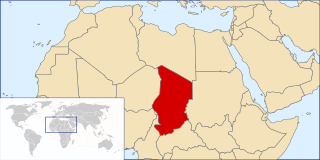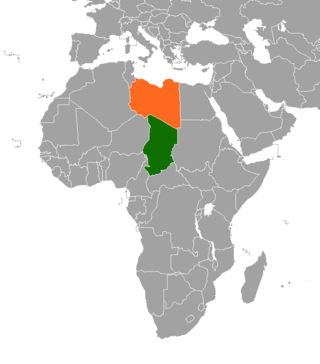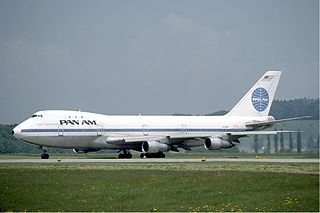
The foreign relations of Libya under Muammar Gaddafi (1969–2011) underwent much fluctuation and change. They were marked by severe tension with the West and by other national policies in the Middle East and Africa, including the Libyan government's financial and military support for numerous paramilitary and rebel groups.

The Aouzou Strip is a strip of land in northern Chad that lies along the border with Libya, extending south to a depth of about 100 kilometers into Chad's Borkou, Ennedi Ouest, Ennedi Est, and Tibesti Regions for an area of 114,000 km2. It is named after the small town and oasis of Aouzou. The region played a significant role in the Chadian–Libyan War.
Operation Épervier was the French military presence in Chad from 1986 until 2014.

The Chadian–Libyan War was a series of military campaigns in Chad between 1978 and 1987, fought between Libyan and allied Chadian forces against Chadian groups supported by France, with the occasional involvement of other foreign countries and factions.

The Toyota War or Great Toyota War was the last phase of the Chadian–Libyan conflict, which took place in 1987 in Northern Chad and on the Chad–Libya border. It takes its name from the Toyota pickup trucks used, primarily the Toyota Hilux and the Toyota Land Cruiser, to provide mobility for the Chadian troops as they fought against the Libyans, and as technicals. The 1987 war resulted in a heavy defeat for Libya, which, according to American sources, lost one-tenth of its army, with 7,500 men killed and US$1.5 billion worth of military equipment destroyed or captured. Chadian forces only suffered 1,000 deaths.

Operation Manta was a French military intervention in Chad between 1983 and 1984, during the Chadian–Libyan conflict. The operation was prompted by the invasion of Chad by a joint force of Libyan units and Chadian Transitional Government of National Unity (GUNT) rebels in June 1983. While France was at first reluctant to participate, the Libyan air-bombing of the strategic oasis of Faya-Largeau starting on July 31 led to the assembling in Chad of 3,500 French troops, the biggest French intervention since the end of the colonial era.
The Maaten al-Sarra Air Base is an airbase in southernmost Libya located near the Ma'tan as-Sarra oasis in the Kufra district. It is one of the 13 military airbases in Libya.
The Battle of Maaten al-Sarra was a battle fought between Chad and Libya on September 5, 1987, during the Toyota War. The battle took the form of a surprise Chadian raid against the Libyan Maaten al-Sarra Air Base, meant to remove the threat of Libyan airpower, that had already thwarted the Chadian attack on the Aouzou Strip in August. The first clash ever held in Libyan territory since the beginning of the Chadian–Libyan conflict, the attack was fully successful, causing a high number of Libyan casualties and low Chadian casualties, also contributing to the definitive ceasefire signed on September 11 among the warring countries.

The Case Concerning the Territorial Dispute [1994] is a public international law case decided by the International Court of Justice. The ICJ ruled in favor of Chad against Libyan Arab Jamahiriya and awarded sovereignty over Aouzou Strip to Chad.

Chad–Libya relations have arisen out of centuries of ethnic, religious, and commercial ties.
UN Security Council Resolution 1834 was adopted unanimously by the 15 member states of the United Nations Security Council, extending the United Nations mission in Chad and the Central African Republic (MINURCAT) until March 15, 2009, which was due to expire on September 25, 2008.

UN Security Council Resolution 731, adopted unanimously on 21 January 1992, after recalling resolutions 286 (1970) and 635 (1989) which condemned acts of terrorism, the Council expressed its concern over the results of investigations into the destruction of Pan Am Flight 103 over Lockerbie, Scotland, and UTA Flight 772 over Chad and Niger which implicated officials from the Government of Libya.

UN Security Council Resolution 748, adopted unanimously on 31 March 1992, after reaffirming Resolution 731 (1992), the UN Security Council decided, under Chapter VII of the United Nations Charter, that the Government of Libya must now comply with requests from investigations relating to the destruction of Pan Am Flight 103 over Lockerbie and UTA Flight 772 over Chad and Niger, calling on Libya to cease all forms of terrorist action and assistance to terrorist groups. To this end, the council imposed sanctions on Libya until Libya complied.

UN Security Council Resolution 883, adopted on 11 November 1993, after reaffirming resolutions 731 (1992) and 748 (1992), the council noted that, twenty months later, Libya had not complied with previous Security Council resolutions and as a consequence imposed further international sanctions on the country.

United Nations Security Council resolution 910, adopted unanimously on 14 April 1994, after considering a letter by the Secretary-General Boutros Boutros-Ghali advising of his intention to send a reconnaissance team to the disputed Aouzou Strip between Chad and Libya, the Council decided to exempt the reconnaissance mission from a provision in Resolution 748 (1992) that imposed international sanctions on Libya.

United Nations Security Council resolution 915, adopted unanimously on 4 May 1994, after reaffirming Resolution 910 (1994), the council, acting on a recommendation by the Secretary-General Boutros Boutros-Ghali, established the United Nations Aouzou Strip Observer Group (UNASOG) to supervise the withdrawal of Libyan forces from the Aouzou Strip following an International Court of Justice opinion that the strip formed part of the territory of Chad.
Aouzou is a small town and oasis in the extreme north of Chad, situated within the Aouzou Strip. It was the site of the Battle of Aouzou, during which Chadian forces captured the town from Libya in August 1987, followed by its recapture by Libya less than a month later. The town was formally transferred to Chadian control in 1994, along with the entirety of the Aouzou Strip.
The Battle of Aouzou refers to a pair of battles fought between Chad and Libya in and around the town of Aouzou (Chad) in August 1987, as part of the Toyota War, the last phase of the larger Chadian–Libyan conflict. The first battle resulted in a Chadian victory, while the second battle, a Libyan counteroffensive, is deemed to have been won by Libya. It was the only Libyan victory of the Toyota War.

The Chad–Libya border is 1,050 km in length and runs from the tripoint with Niger in the west, to the tripoint with Sudan in the east.

The United Nations Aouzou Strip Observer Group (UNASOG) was a United Nations observation mission that was deployed to the Aouzou Strip, in the Republic of Chad. Established in the wake of the Aouzou Strip dispute under Security Council Resolution 915 of 4 April 1994, the mission's mandate was "to verify the withdrawal of the Libyan administration and forces from the Aouzou Strip in accordance with the decision of the International Court of Justice".













